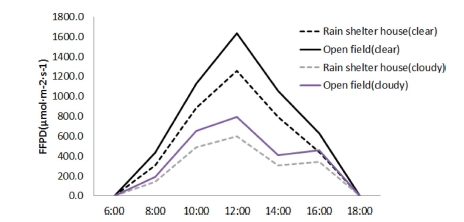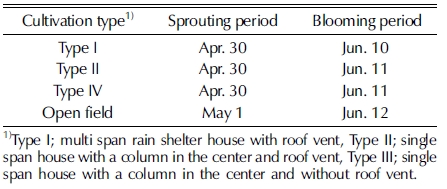
비가림하우스 유형별 대추의 생육 및 과실 특성
© The Korean Society of Medicinal Crop Science. All rights reserved.
This is an Open-Access article distributed under the terms of the Creative Commons Attribution Non-Commercial License ( http://creativecommons.org/licenses/by-nc/3.0 ) which permits unrestricted non-commercial use, distribution, and reproduction in any medium, provided the original work is properly cited.
Abstract
Recently, jujube (Zizyphus jujuba Mill.) has been attracting attention as a fruit, and its cultivation in rain shelter house is increasing to produce the high quality fresh jujube. This study was carried out to investigate the growth and fruit characteristics of jujube according to the types of rain shelter house.
The characteristics of 5-year-old Bokjo cultivar cultivated in 3 types of rain shelter house, multi span rain shelter house with roof vent (Type I), single span house with a column in the center and roof vent (Type II) and single span house with a column in the center and without roof vent (Type III), and open field were examined. The sprouting and blooming period were different among the types of rain shelter house. The diameter of main stem was higher in rain shelter houses than in the open field. There was no a significant difference in fruit number per leaf stem among the types of cultivation. The incidence of fruit cracking in open field cultivation which was 51.2% was much higher than that in Type I 21.6%, Type II 19.3%, and Type III 25.5%. The fruit size and weight in rain shelter houses, especially in Type III rain shelter house were higher than those in the open field and the soluble solids content of fruit in Type I and Type II was higher than in Type III rain shelter house and the open field.
The results show that the growth and fruit quality of jujube were improved by cultivation in rain shelter house, and affected by the types of rain shelter house.
Keywords:
Zizyphus jujuba Mill, Jujube, Rain Shelter House, Fruit Size, Fruit Weight, Fruit Cracking서 언
갈매나무과 (Rhamnaceae)에 속하는 대추 (Zizyphus jujuba Mill)는 오랫동안 건대추의 형태로 한약이나 음식의 재료로 이 용되어 왔으나, 최근 충북 보은지역을 중심으로 생대추용으로 생산하여 과일로 판매하고 있다.
생대추는 건대추에 비해 가격이 높아 국내에서의 생산량 비 중이 13.7%에 불과한 충북지역의 생산액은 234 억원으로 29.6%에 이른다 (KFS, 2017). 생대추용 대추는 건대추에 비 해 높은 품질이 요구되는데 과실의 크기가 크고, 과실 표면에 상처가 없어야 한다. 탄저병 (Kim et al., 2016), 세균열매썩 음병 (Myung et al., 2010) 같은 병해와 열과 등에 의한 생 리장해는 과실에 직접 영향을 주어 품질을 떨어뜨리는 요인으 로 강우 등과 같은 기상 여건과 직접적인 관련이 있다.
시설재배는 기상여건에 따른 영향을 감소시킬 수 있어 포 도, 배, 복숭아, 감귤 등에 적용되고 있다 (Nam et al., 2013). 과수에 있어서 비가림 재배 효과는 과실의 품질 변화 와 생육 증진 (Kim et al., 2011;Ahn et al., 2012;Meng et al., 2017), 내한성 증가 (Ahn et al., 2012), 병 발생 감소 (Lee et al., 2015) 등이 알려져 있으며 대추에 있어서도 최근 비가림하우스 재배 면적이 증가하고 있다 (Kim et al., 2017).
충북 보은지역에 보급되어 있는 비가림하우스 형태는 주로 측면에 비닐이 없는 천창개폐형 연동하우스, 대추나무 열을 따 라 비가림을 설치하고 동과 동 사이에 공간이 없는 천창개폐 형 단동하우스와 동간 간격이 있는 천창 비가림이 고정된 단 동하우스이다 (Kim et al., 2017). 비가림하우스 내의 환경은 하우스 유형별로 차이가 나고 대추의 품질에 영향을 줄 수 있 으나 이에 대한 정보가 없는 상황이다.
따라서, 본 연구는 국내 재배 면적의 대부분을 차지하는 ‘복조’ 품종에 대해서 비가림하우스 유형별 생육과 과실 특성 을 조사하여 고품질 생대추 생산을 위한 자료로 활용하기 위 해 수행되었다.
재료 및 방법
1. 시험 재료 및 비가림하우스
충청북도 보은군에 위치한 충청북도농업기술원 대추연구소 시험포장에 설치되어 있는 세 가지 유형의 비가림하우스와 노 지의 대추 (Zizyphus jujuba Mill) 5년생 ‘복조’ 품종을 대상 으로 시험을 실시하였다. 대추나무는 이랑간격 4 m, 주간거리 2m로 식재되었고 비가림 하우스는 대추 식재 1 년 후에 설치 되었다.
시험장소인 비가림하우스의 유형별 규격과 외부 형태는 각 각 Table 1, Fig. 1과 같다. Type I은 연동형 비가림하우스이 며 천창개폐가 가능하고, Type II는 천창 개폐가 가능하고 동 간 간격이 없으며, Type III는 천창고정형이며 동간 거리가 0.7 m이다. Type II와 Type III은 기둥이 동 중앙에 위치하는 단동형으로 하우스당 1줄씩 대추나무가 식재되었다. 천창개폐 가 가능한 비가림 유형은 착과기까지는 우적센서 (Woosung Tech, Cheongju, Korea)로 관리하였으며, 착과기 이후에는 천 창을 닫아두었다.
2. 기온 및 광합성 유효광량자속 밀도 측정
기온 측정을 위해 Thermo recorder (T&D Corporation, Matsumoto, Japan)를 나무 사이에 높이 1.5 m 정도가 되도록 설치하였다. 광합성유효광량자속밀도 (photosynthetic photon flux density, PPFD)는 Quantum sensor (APOGEE Instruments, Auburn, CA, USA)를 노지와 Type III 비가림하 우스 대추나무 사이에 1 m 높이로 설치하여 측정하였다.
3. 생육 및 과실 특성
비가림하우스 유형별 ‘복조’ 대추의 생육 및 과실 특성은 농 업과학기술 연구조사분석기준 (RDA, 2003)에 따라 조사하였 다. 발아기는 눈의 인편이 1 - 2㎜ 나온 눈이 40 - 50% 되었 을 시기를, 개화기는 한 나무에서 10% 정도 개화되었을 시기 를 조사하였다.
수체의 굵기는 2016년 5월 25일 지제부에서 10㎝ 상부의 위치에서 버니어 캘리퍼스 (Mitutoyo Co., Kawasaki, Japan) 를 이용하여 측정하였다. 잎줄기당 착과수는 주당 10 개의 잎 줄기를 선정하여 9월 5일 묵은 가지와 새가지 착과를 구분하 여 조사하였다. 열과율은 주당 10 개의 잎줄기에 있는 총 과 실수에 대한 열과된 과실의 수를 백분율로 표시하였다. 과실 의 특성은 주당 20 개의 과실을 조사하였다. 과실의 크기는 버니어캘리퍼스를 이용하여 측정하였고, 경도는 과실 경도 측 정기(TAKEMURA Co., Tokyo, Japan)를 이용하였으며, 당도 는 휴대용 디지털당도계 (ATAGO Co., Tokyo, Japan)를 이용 하여 측정하였다.
4. 통계처리
조사 결과는 SPSS 프로그램 (SPSS Inc., Chicago, IL, USA)을 이용하여 p < 0.05 수준에서 Duncan’s Multiple Range Test (DMRT)를 실시하였다.
결과 및 고찰
1. 비가림하우스와 노지에서의 대추 생육 특성
노지와 비가림하우스 유형별 대추 (Zizyphus jujuba Mill)나 무의 발아기와 생육기 조사 결과, 발아기는 모든 비가림하우 스 유형에서 4월 30일이었으며, 노지보다 1 일 빨랐다. 개화 기는 연동형 비가림하우스 (Type I)에서 6월 10일로 단동형 비가림하우스에 비해 1 일 빨랐으며, 노지에 비해서는 2 일 정도 빨랐다 (Table 2).

Sprouting and blooming periods of ‘Bokjo’ cultivar in the three types of rain shelter house and open field.
발아부터 개화까지 소요 일수는 40 - 41 일 범위로 재배 유 형에 따른 차이가 거의 없는 것으로 나타났다. 비가림 재배에 의한 과수의 생육 촉진 효과는 블루베리, 포도 등에서 보고 되어있으나 (Kim et al., 2011;Lee et al., 2015), 대추는 다 른 과수에 비해 비가림 재배에 의한 생육 촉진 효과가 미미하 게 나타났다 (Fig. 2).
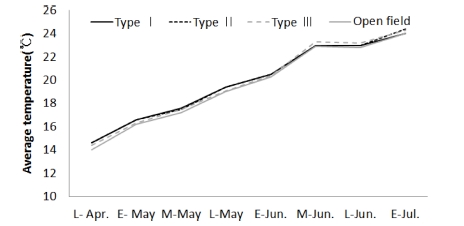
Average air temperature in the three types of rain shelter house and open field during sprouting and flowering period of jujube.Type I; multi span rain shelter house with roof vent, Type II; single span house with a column in the center and roof vent, Type III; single span house with a column in the center and without roof vent.
이는 대추가 주로 온도에 영향을 받아 생육이 촉진되는 데 (Kim et al., 1988), 4월 하순부터 7월 상순까지 평균기온이 세 유형의 비가림하우스와 노지에서 큰 차이가 없는 것 (Fig. 2)이 원인으로 생각된다.
주간의 굵기는 재배유형에 따라 차이가 났는데, 천창고정형 단동 비가림하우스 (Type III) 와 천창개폐형 연동 비가림하우스 (Type I) 에서는 노지에 비해 유의한 차이가 나타났다 (Fig. 3).
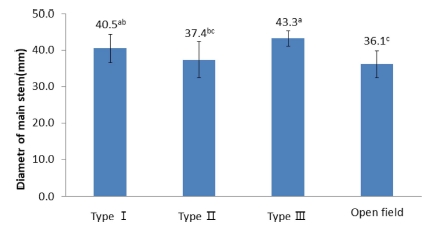
Diameter of main stem of jujube tree in the three types of rain shelter house and open field.Type I; multi span rain shelter house with roof vent, Type II; single span house with a column in the center and roof vent, Type III; single span house with a column in the center and without roof vent. *Mean separation within columns by Duncan’s Multiple Range Test (DMRT) at 5% level (p < 0.05). Bars are means ± SD (n = 12).
나무의 굵기는 나무의 생육 정도를 나타내는 주요한 요소로 (Richard et al., 2000), 천창이 고정되어 연중 비가림막이 되 어 있는 Type III의 비가림하우스에서 대추의 생육이 가장 활 발하였다.
비가림하우스 유형과 노지에서의 개화 결실기의 평균기온 차이가 크지 않으므로 동절기의 미세환경, 토양 특성 등 생육 에 영향을 줄 수 있는 요인에 대한 추가 분석이 필요하며, Kwon 등 (2007)은 균일한 배를 생산하기 위해 나무의 굵기에 따른 전정량을 제시하였는데, 비가림 유형별 대추나무의 적정 전정량에 대한 연구도 추가적으로 필요한 것으로 생각되었다.
2. 비가림 하우스와 노지에서의 대추 생리장해 발생
과수에 있어서 열과의 발생은 보통 수확기에 근접하여 과실 로 갑자기 물이 흡수되어 발생한다. 대추는 이와 더불어 강한 햇빛을 받아 과실의 표피가 갈변하는 일소 피해가 발생하면 열과로 진행되어 발생이 증가한다 (Kim et al., 2017). 따라서, 갑자기 토양수분이 증가되는 것을 막으며 수분적절한 관수를 통해 토양 수분 변화를 적게 하고 (Kim et al., 2006), 차광 에 의한 일소 방지를 통해 열과 발생을 줄일 수 있다고 알려 져 있다 (Lee et al., 2015).
본 연구에서도 노지에서의 열과 발생율이 51.2%인데 비해 비가림하우스에서의 열과 발생율은 19.3 - 25.5% 범위로 현저 히 낮았다 (Fig. 4). 그러나 비가림하우스 유형별로는 차이가 없었다. 열과는 대추 상품과율에 가장 크게 영향을 주는 생리 장해로 비가림 재배가 생대추 상품과율을 높이는데 효과적임 을 알 수 있었다.
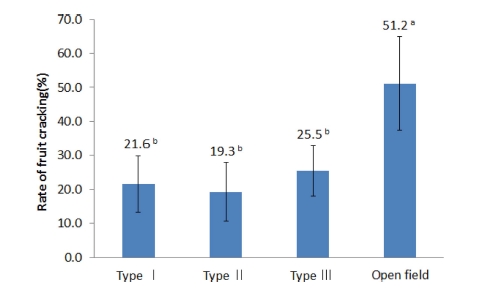
Occurrence of jujube fruit cracking according to the types of rain sheltering house.Type I; multi span rain shelter house with roof vent, Type II; single span house with a column in the center and roof vent, Type III; single span house with a column in the center and without roof vent. *Mean separation within columns by Duncan’s Multiple Range Test (DMRT) at 5% level (p < 0.05). Bars are means ± SD (n = 3).
3. 비가림 하우스와 노지에서의 대추 착과 및 과실 특성
잎줄기당 착과수는 재배 유형별 차이가 없었다 (Fig. 5). 대 추는 묵은가지와 새가지에 모두 착과가 이루어지는데, 생과용 대추를 생산하기 위해서는 강전정을 통한 새가지 착과를 유도 하는 것이 일반적이다 (Kim et al., 2017).
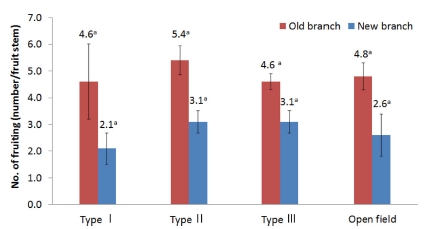
Number of fruiting of jujube in the three types of rain shelter house and open field.Type I; multi span rain shelter house with roof vent, Type II; single span house with a column in the center and roof vent, Type III; single span house with a column in the center and without roof vent. *Mean separation within columns by Duncan’s Multiple Range Test (DMRT) at 5% level (p < 0.05). Bars are means ± SD (n = 3).
본 연구의 결과, 비가림 재배가 새 가지와 묵은 가지 모두 대추 착과에는 영향을 주지 않는 것으로 나타났다. 그러나 대 추 과실의 크기, 과중, 경도 및 가용성 고형물 함량은 비가림 재배에 의해 전반적으로 향상되었다 (Table 3).
과실의 크기는 Type III 비가림하우스에서 가장 컸으며, 가 용성 고형물 함량은 Type I과 Type II 비가림하우스에서 노지 재배에 비해 높았으나, Type III 비가림하우스에서는 노지와 차이가 없었다. 반면, 과실의 경도는 재배 유형에 영향을 받지 않았다.
Lee 등 (2015)은 포도 켐벨얼리 품종에서도 비가림 재배에 의해 과립수가 많아지고 가용성 고형물 함량이 향상되었다고 보고한 반면, 블루베리에 있어서는 광조건이 불리할 경우 광 합성의 차이로 가용성 고형물 함량이 떨어진다고 (Kim et al., 2011) 하였다.
Type III 비가림하우스에서 맑은날 (9월 21일) 12시에 측정 한 PPFD는 1,256 μmol·m−2·s−1로 노지에 비해 23.1% 정도 감소되었으며, 흐린날 (9월 28일)에는 601 μmol·m−2·s−1로 20.9% 감소되었다 (Fig. 6).
노지의 PPFD가 비가림하우스에 비해 2배 정도 높다는 보 고 (Kim et al., 2011)에 비해 본 연구의 비가림하우스에서는 PPFD 감소율이 적게 나타났다. Su 등 (2005)은 Linze 대추의 광 보상점과 광포화점을 각각 28과 1,000 μmol·m−2·s−1이라고 보고 하였는데, 본 연구에 사용된 복조 품종의 경우, 비가림막 에 의한 PPFD의 감소가 대추 과실의 품질에 영향을 주지 않 은 것으로 생각되었다.
본 연구 결과로 비가림 재배가 생대추의 품질을 높이고 상 품과율을 높일 수 있는 좋은 방법으로 생각되었다. 그러나 실 제 대추과원에서 비가림하우스를 적용할 때는 농가의 재배방 법, 대추나무 수령, 과원이 위치한 곳의 지형과 기상 특성 등 을 고려하여 비가림 유형을 선택하여야 하며, 비가림 재배의 효과를 높이기 위해서는 앞으로 비가림 재배에 맞는 시비 및 전정방법 등이 함께 개발되어야 할 것이다.
감사의 글
본 연구는 농촌진흥청 대추 재배용 비가림하우스 재배실증 연구(과제번호: PJ012297022018)의 지원에 의해 이루어진 것 으로 이에 감사드립니다.
References
-
Ahn, SY, Kim, SH, Choi, SJ, Choi, HK, (2012), Characteristics of cold hardiness and growth of grapevines grown under rain shelter type cultivation system in the vineyard, Korean Journal of Horticultural Science and Technology, 30, p626-634.
[https://doi.org/10.7235/hort.2012.12102]

- Kim, BS, Na, YK, Cho, KC, Hwang, IT, Kim, JG, (2006), Effect of irrigation methods on fruit cracking of tetraploid grape in protected cultivation, Journal of Bio-environment Control, 15, Supplement Ip186-191.
- Kim, JG, Jo, JG, Kim, HL, Ryou, MS, Kim, JB, Hwang, HS, Hwang, YS, (2011), Growth and fruit characteristics of blueberry ‘Northland’ cultivar as influenced by open field and rain shelter house cultivation, Journal of Bio-Environment Control, 20, p387-393.
- Kim, SH, Lee, KH, Lee, JW, Kim, CW, Oh, HK, Kee, SK, Kang, HJ, Hong, EY, Na, KH, (2017), Jujube cultivation techniques, Chungbuk Agricultural Research and Extension Services, Cheongju, Korea, p1-86.
- Kim, SH, Park, SH, Kim, MK, Lee, SH, (2016), Flower browning as infection source with anthracnose on jujube, Fruit Growing Research, 32, p59-62.
- Kim, YS, Kim, WS, (1988), New technology of jujube cultivation, Osung Publishing House, Seoul, Korea, p138-142.
- Korea Forest Service(KFS), (2017), Statistical yearbook of forestry Kroea Forest Service, Daejeon, Korea, p286-287.
- Kwon, YH, Shin, YH, Park, HS, Jung, HW, Lee, JY, (2007), Crop load adjustment based on tree vigor for producing uniform fruits in ‘Niitaka’ pear trees, Horticulture Environment and Biotechnology, 48, p109-114.
-
Lee, YS, Kim, SD, Lee, SH, Hong, ST, Lee, JW, Hong, EY, Kim, DI, (2015), Characteristics of the newly developed rain shelter for grapevine and growth of ‘Campbell Early’, Protected Horticulture and Plant Factory, 24, p252-257.
[https://doi.org/10.12791/KSBEC.2015.24.3.252]

-
Meng, N, Ren, ZY, Yang, XF, Pan, QH, (2017), Effects of simple rain-shelter cultivation on fatty acid and amino acid accumulation in ‘Chardonnay’ grapeberries, Journal of the Science Food and Agriculture, 98, p1222-1231, 28755408.
[https://doi.org/10.1002/jsfa.8593]

-
Myung, IS, Moon, SY, Jeong, IH, Lee, SW, Ra, RS, (2010), A new disease, bacterial fruit rot of jujube, caused by Xanthomonas arboricola in Korea, New Disease Reports, 22, p12-12.
[https://doi.org/10.5197/j.2044-0588.2010.022.012]

-
Nam, SW, Ko, GH, (2013), Analysis of structural types and design factors for fruit tree greenhouses, Protected Horticulture and Plant Factory, 22, p27-33.
[https://doi.org/10.12791/KSBEC.2013.22.1.027]

- Richard, PM, Donald, SS, (2000), Peach tree growth, yield, and profitability as influenced by tree form and tree density, HortScience, 35, p837-842.
- Rural Development Administration(RDA), (2003), Agricultural examination reach investigation standard, Rural Development Administration, Wanju, Korea, p576-614.
-
Su, P, Liu, X, (2005), Photosynthetic characteristics of linze jujube in conditions of high temperature and irradiation, Scientia Horticulture, 104, p339-350.
[https://doi.org/10.1016/j.scienta.2004.08.012]


